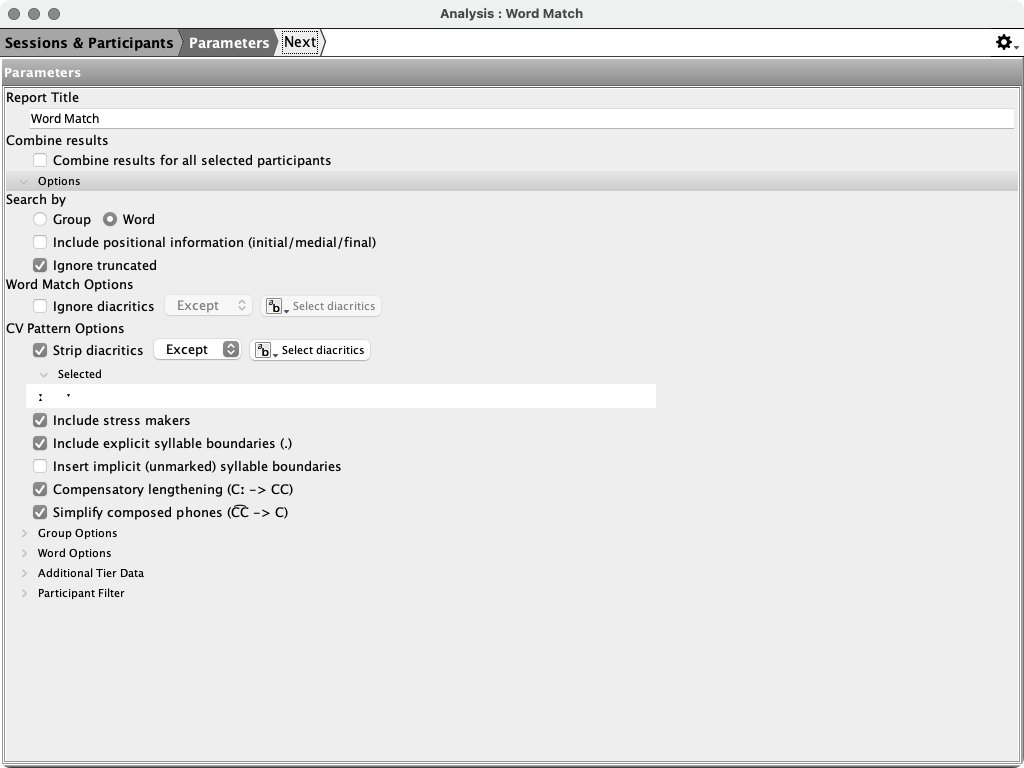Word Match
The Word Match analysis offers a series of whole-word assessments of pronunciation accuracy, accounting for matches and mismatches for the whole word, CV word shape, syllable number (word length), and stress patterns.
Parameters

- Word Match Options - these options affect how comparisions between IPA Target and IPA Actual words are performed. (See Diacritic Options)
- CV Pattern Options - these options affect how the CV pattern of IPA
transcripts is constructed.
- Strip diacritics - See Diacritic Options
- Include stress markers
- Include explicit syllable boundaries (syllable breaks marked with a dot '.')
- Insert implicit syllable boundaries - insert a dot at every syllable break which is not marked with stress.
- Compensatory lengthening - any C or V marked with a long or halflong diacritic will be doubled. Note: if length diacritics are ignored then this setting will have no effect.
- Simplify composed phones - phones composed with a ligature will be reduced to a single character.
Other parameters
Report Outline
A sample table of contents is displayed below. Bold level elements are section headers while italic items are tables.
-
Word Match
- Summary (all participants)
-
Participant 1
- Summary
- Matches
- Mismatches
- CV Pattern Matches
- CV Pattern Mismatches
- Stress Matches
- Stress Mismatches
- Syllable Count Matches
- Syllable Count Mismatches
- … (for each selected participant)
- Listing (all results)
Example
Click the link below to view an example report.
References
Whole word match
Bernhardt, B.M., Stemberger, J.P., Bérubé, D., Ciocca, V., Freitas, M.-J., Ignatova, D., Kogošek, D., Lundeborg Hammarström I., Másdóttir, T., Ozbič, M., Perez, D. & Ramalho, A.M. 2020. Identification of protracted phonological development across languages - The Whole Word Match and basic mismatch measures. In E. Babatsouli, M. Ball & N. Müller (eds.), AnAnthologyofBilingualChildPhonology (pp.274-308). Bristol, UK: Multilingual Matters. doi.org/10.21832/BABATS8410
Available at http://phonodevelopment.sites.olt.ubc.ca/.
Word structure measures
Bernhardt, B., & Gilbert, J. 1992. Applying linguistic theory to speech-language pathology: the case for nonlinear phonology. Clinical Linguistics and Phonetics, 6, 123-145.
Bernhardt, B.M., Hanson, R., Perez, D., Ávila, C., Lleó, C., Stemberger, J.P., Carballo, G., Mendoza, E., Fresneda, D. & Chávez-Peón, M. 2015. Word structures of Granada Spanish-speaking preschoolers with typical versus protracted phonological development. Intl. Jnl. of Lang. & Communication Disorders, 50(3), 298-311. DOI: 10.1111/1460-6984.12133.
Bernhardt, B.M. & Stemberger, J.P. 2000. Workbook in nonlinear phonology for clinical application. Copyright with authors, available at phonodevelopment.sites.olt.ubc.ca (Test Materials/English, at the bottom).
Romonath, R. & Bernhardt, B.M. 2017. Erwerb prosodischer Wortstrukturen bei Vorschulkindern mit und ohne phonologische Störungen [Prosodic word structure acquisition in preschool children with and without phonological disorders]. Forschung Sprache 1, 91-107.
Stemberger, J.P. & Bernhardt, B.M. 2018. Tap and trill clusters in typical and protracted phonological development: Challenging segments in complex phonological environments. Introduction to the special issue, Clinical Linguistics and Phonetics, 32 (5-6), 563-575.

 Example Report
Example Report